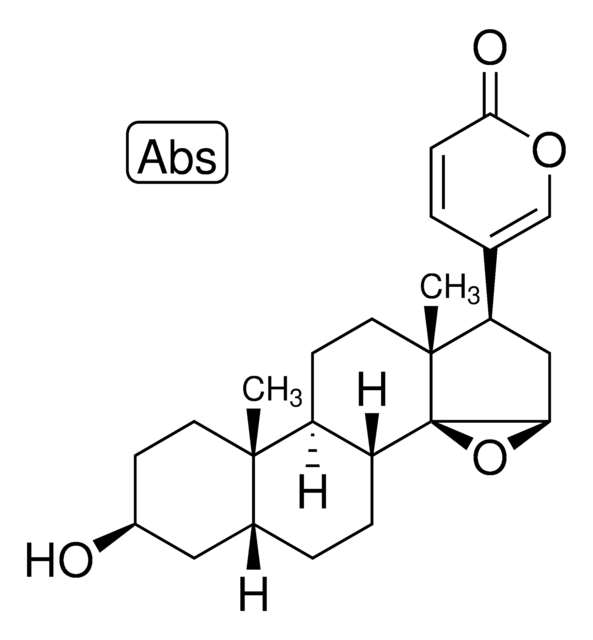SBR00068
Streptomycin Ready Made Solution
100 mg/mL in water
Sign Into View Organizational & Contract Pricing
All Photos(2)
About This Item
Recommended Products
form
liquid
Quality Level
specific activity
(Antibacterial)
concentration
100 mg/mL in water
antibiotic activity spectrum
Gram-negative bacteria
Gram-positive bacteria
mycobacteria
Mode of action
protein synthesis | interferes
storage temp.
−20°C
General description
Chemical structure: aminoglycoside
Application
Streptomycin is used to study mechanisms of streptomycin resistance and is often used together with penicillin and other agents to inhibit bacterial contamination in cell culture applications. It is recommended for use in molecular biology applications at 25-50 μg/mL, in cell culture applications at 100 mg/L and in embryo culture at 50 mg/L.
Biochem/physiol Actions
Mode of Action: Streptomycin acts by inhibiting prokaryote protein synthesis by binding to the S12 protein of the 30S ribosomal subunit, thus preventing the transition from imitation complex to chain-elongating ribosome. This causes miscoding or inhibits initiation.
Mode of Resistance: A mutation in rpsL, a gene for S12 ribosomal protein, prevents binding of streptomycin to the ribosome. An aminoglycoside phosphotransferase also inactivates streptomycin.
Antimicrobial spectrum: Streptomycin acts against gram-negative and gram-positive bacteria.
Mode of Resistance: A mutation in rpsL, a gene for S12 ribosomal protein, prevents binding of streptomycin to the ribosome. An aminoglycoside phosphotransferase also inactivates streptomycin.
Antimicrobial spectrum: Streptomycin acts against gram-negative and gram-positive bacteria.
Storage and Stability
- Streptomycin ready made solution contains 100 mg/mL streptomycin sulfate in water.
- Streptomycin: sulfate salt ratio is 1:1.5.
- The product is packed under aseptic conditions.
Signal Word
Warning
Hazard Statements
Precautionary Statements
Hazard Classifications
Repr. 2
Storage Class Code
10 - Combustible liquids
WGK
WGK 3
Choose from one of the most recent versions:
Certificates of Analysis (COA)
Lot/Batch Number
Sorry, we don't have COAs for this product available online at this time.
If you need assistance, please contact Customer Support.
Already Own This Product?
Find documentation for the products that you have recently purchased in the Document Library.
Dominic Leiser et al.
Molecular oncology, 9(7), 1434-1446 (2015-05-03)
The MET receptor tyrosine kinase is often deregulated in human cancers and several MET inhibitors are evaluated in clinical trials. Similarly to EGFR, MET signals through the RAS-RAF-ERK/MAPK pathway which plays key roles in cell proliferation and survival. Mutations of
Daniela Lobenwein et al.
Journal of the American Heart Association, 4(10), e002440-e002440 (2015-10-29)
Paraplegia following spinal cord ischemia represents a devastating complication of both aortic surgery and endovascular aortic repair. Shock wave treatment was shown to induce angiogenesis and regeneration in ischemic tissue by modulation of early inflammatory response via Toll-like receptor (TLR)
Yajie Zhu et al.
International journal of oncology, 44(3), 896-904 (2014-01-09)
Previous studies have shown that RhoE, an atypical member of the Rho GTPase family, may play an opposite role to RhoA in regulating cell proliferation and invasion. To explore the relationship between RhoE and the malignant phenotypes of human cancer
Chatla Srinivas et al.
PloS one, 10(11), e0142006-e0142006 (2015-11-10)
Tumor microenvironment play role in angiogenesis and carcinogenesis. Etoposide, a known topoisomerase II inhibitor induces DNA damage resulting in cell cycle arrest. We developed a novel Etoposide analogue, Quinazolino-4β-amidopodophyllotoxin (C-10) that show better efficacy in regulating cell proliferation and angiogenesis.
Chengfei Zheng et al.
Molecular medicine reports, 12(5), 6656-6662 (2015-09-02)
Aortic aneurysm is a cardiovascular condition with a serious risk of mortality and the dismal prognosis of any type of major cardiovascular disease. The present study found that tissues from aortic aneurysm patients and hypoxic aortic smooth muscle cells showed
Our team of scientists has experience in all areas of research including Life Science, Material Science, Chemical Synthesis, Chromatography, Analytical and many others.
Contact Technical Service





